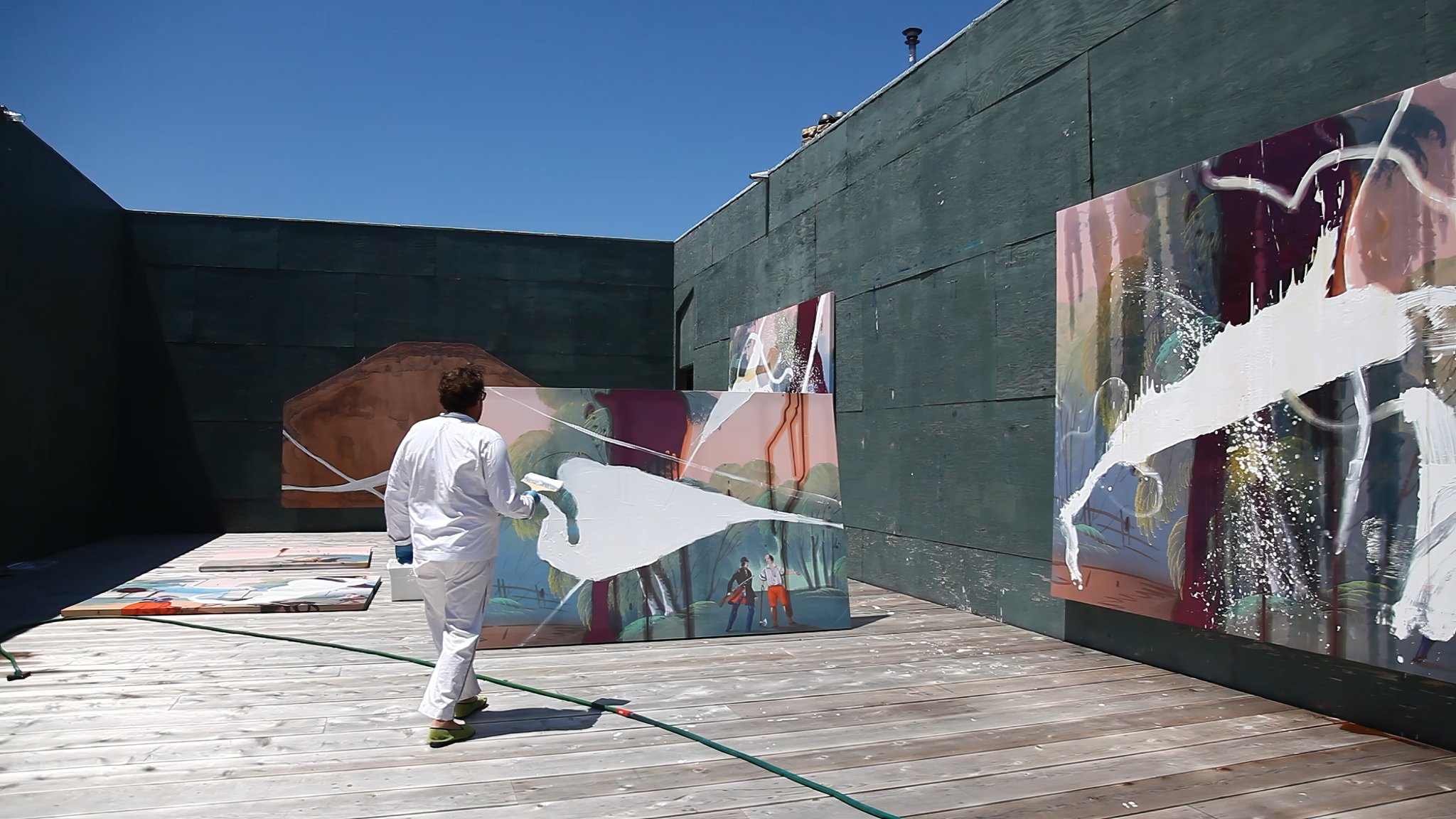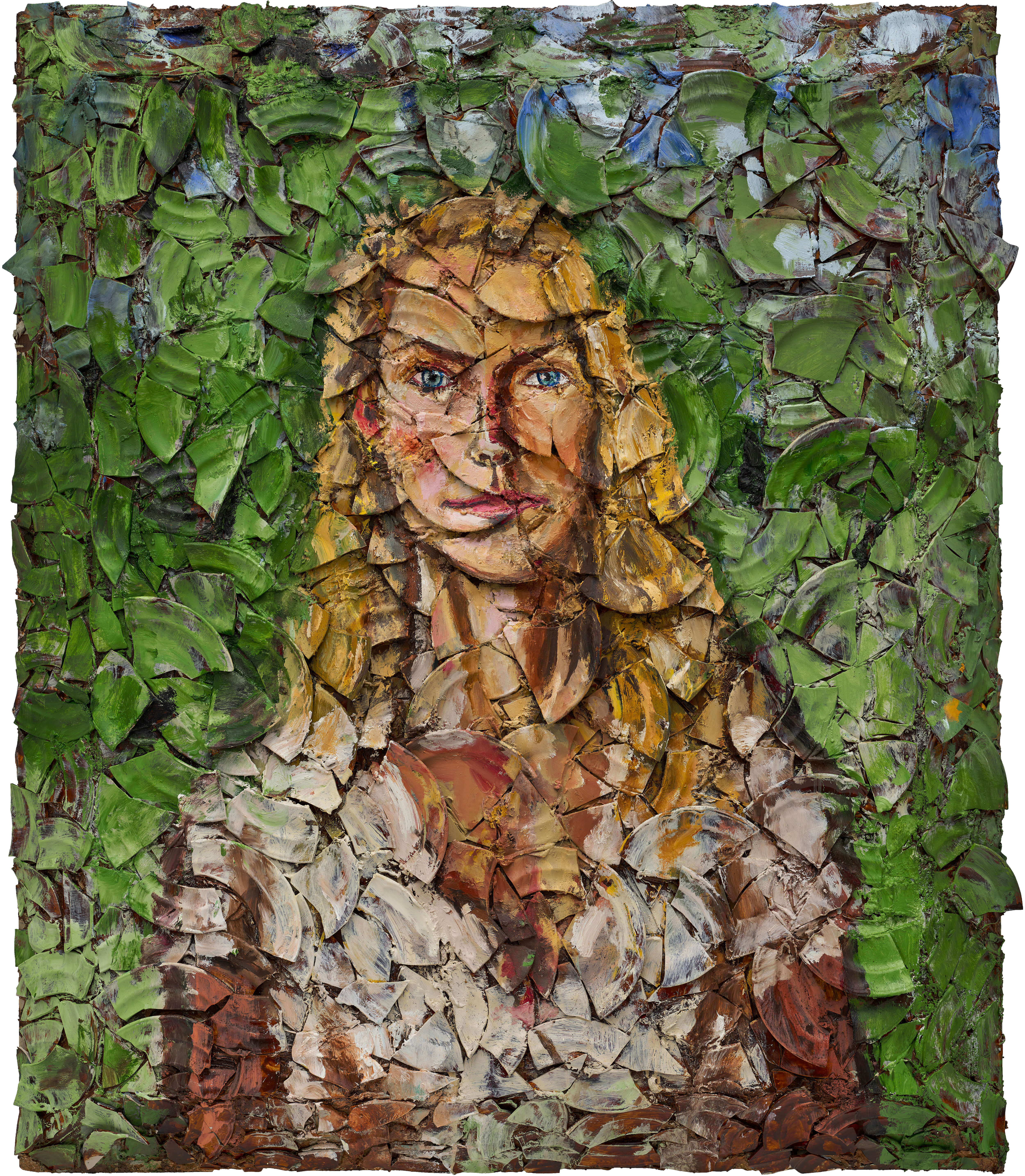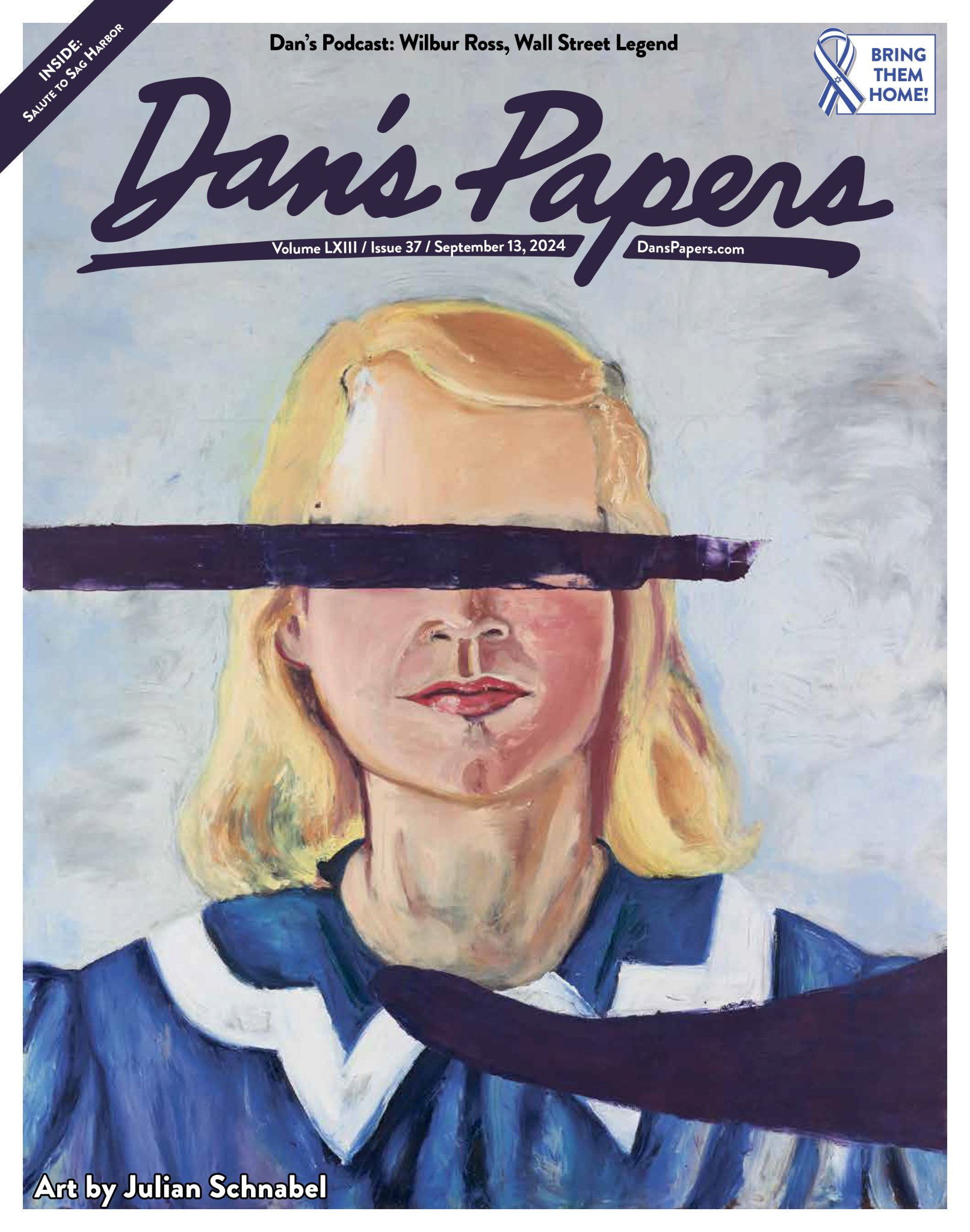Julian Schnabel Discusses Guild Hall Show & 'The Girl with No Eyes'

This week’s Dan’s Papers cover art, “The Girl with No Eyes” (2001, oil and wax on canvas, 162 x 148 inches) comes to us from Montauk resident Julian Schnabel, one of the world’s most famous and respected living artists and filmmakers who is currently showing Julian Schnabel: Selected Works from Home at Guild Hall in East Hampton through October 27.
The exhibition features a carefully curated selection of his paintings, drawings and sculptures from the last 45 years, almost all of them pulled from his personal collection, which Schnabel has kept to live among and continue contemplating in his own home.

A Conversation with Julian Schnabel
Why do you decide to keep certain pieces of art in your own collection, rather than selling them?
Because I’d rather have the paintings than the money. Usually, I mean, the paintings that I’ve kept are things that maybe I made them, they were some kind of epiphany, I felt like I could learn something from them, so I keep looking at them. Maybe that’s the criteria for keeping them — that I actually I came upon something that was a surprise to me, and I wanted to keep looking at it. If I didn’t have to sell it, then I wouldn’t.
How did you decide on which pieces to show at Guild Hall?
I took all the paintings that were in my living room, and they were more or less the same scale. The room was more or less the same scale as the museum. And so it was a relatively easy fit. …three paintings came from my son Vito’s house, and one painting came from Sandy Brandt’s collection. But essentially, they’re all paintings that, except for Sandy’s painting, have lived in the building at West 11th Street.

“The Girl with No Eyes” is the centerpiece of the show and is the cover of this week’s Dan’s Papers. Can you tell me something about this series of paintings, how it came to be, why you were driven to paint her so many times, and why you keep coming back to her?
I was in Texas, and I went into a junk shop and I found some paintings, and I added some purple paint to them. I called that group of these small paintings, “Veramente Bestia,” “Real Beast,” which was a line out of The Godfather II. … And this particular painting was made by a lady named Childress. It’s probably of her daughter in a school outfit. And I’m sure she never thought that it would become something else, other than the painting of her daughter. I painted some purple paint over the eyes and a couple of other purple marks on the frame, and I left it like that.
That was 1988, and in 2001 I looked at it and I thought, well, that could be a model for a painting. So I held the painting in my hand, in one hand, and I made some paintings … I made three groups. Four paintings were 13.5 feet by 12 feet. There were five that were 7.5 by 7 feet, and five that were 9 by 8 feet. Essentially, they were all the same. A young child saw the paintings, and he said, “Well, they’re all the same, but they’re all different.” I thought, yeah, that’s true.
You have an incredible painting setup in Montauk — we’ve seen pictures of your outdoor studio (see above). How much of your work is being done out here versus in New York City?
I like to paint outside. I usually spend four months of the year in Montauk. And lately, if I was making a film, less probably. But also, we have a place in Mexico, and I work outside there. I paint out in Troncones, and I find materials where I am. For example, there might be a material that was covering a toy store, like a tienda, a tent over it, and maybe I’ll buy that material from the guy and buy his toy store, use that material because I thought that the color pink bleached by the sun was something very specific, and spoke to me, or I’ll go to a fruit market, and there’s pieces of material that cover the fruit and the people that are buying the vegetables, and I’ll ask if I could buy them some new material because the way the fabric reacts to the sun is something that I find compelling.
Also, it has to do with life. I mean, these things are used by people, and there’s a palimpsest, there’s things as life goes on: They get stained. There are marks. They get torn. It’s something away from the pristine. It’s not even a reaction to this pristine white canvas you buy at an art supply store. It’s another thing.
You incorporate frames into your paintings, and make the frame a part of the painting, including a number of pieces in “The Girl with No Eyes” series. Can you talk about this?
Well, where is the edge? Where is the edge of a picture? Is it supposed to be contained in the frame, or does the painting go past the frame? And then we’re talking about different use of these things. Because if you look at the “Winter” painting that’s at the show there, there’s actually a frame that’s protruding out of part of the image, as if it was just another piece of debris that you were covering with paint. And then there are other paintings where the frame has a colloquial subtext that makes you feel the sense of giving you a set of glasses to put on when you’re looking at it.
For example, we’re sitting in here. We’re sitting in the studio, and there’s a billboard painting that I painted. I made a tarp painting, painted the tarp Naples yellow, but I built a frame around it and legs for it to stand on so it looks like a billboard that was outside. It looks like a found object, but it’s made from scratch.

Speaking of frames, how do you feel when a collector is choosing a frame for a painting they buy from you, given the way it changes the painting?
I don’t have any feelings about that. Cy Twombly picked up two drawings off the floor in my studio in 1985 that looked like throwaways or something, but he liked those drawings. And some years later, his brother in-law, Giorgio Franchetti, took me over to his house in Bassano, and these two drawings were framed in 16th century Italian frames next to his bed. And I was very touched by that.
I like old frames, and sometimes I think it’s nice to put works on paper in old frames. Obviously, I’ve done a lot of experimenting with frames, some framed paintings. Some are parts of moldings that just end up being a part of the surface of a painting.
I absolutely loved your film, Basquiat. I’ve watched it more than 100 times, especially as a young art student in the 1990s. Are you working on any new film projects?
I just finished directing a movie called In the Hand of Dante based on a book by Nick Tosches, and it stars Oscar Isaac as Dante and Nick Tosches, he plays both roles, and Gerard Butler is in the movie playing dual roles, and Gal Gadot is in the film. And Marty Scorsese was in the film, and Al Pacino and Jason Momoa, and a bunch of great Italian actors also. We filmed it almost completely in Italy, except for exteriors that we shot in three days in New York City.
Given that you kept (nearly) all the pieces in this exhibition, can you talk about one painting in particular that’s extra special to you?
Well, there’s one that’s extra special to me that doesn’t belong to me, and it’s the one that Sandy Brandt owns, called “Accattone.” And when I made it, it was kind of a revelation to me. It’s just a wax painting with a mailbox type shape cut out of it and a torso painted on a plinth made with wax. I don’t think you can explain why something means something to you, really. It’s as if a window opened or a door opened to something else, and so and it had the stability of keeping that door open as long as I looked at it. And I also named it “Accattone” Because I love the film Accattone by Pier Paolo Pasolini. I don’t know if that’s misleading or not, but I love the movement. I love the painting. So why not?
Is there anything I’m not asking that I should be, or is there something you’d like to add?
I was extremely pleased and satisfied with the way the paintings were presented at the museum, and the way that the people at the museum cared about the show and went to all lengths to make it exactly the way that I wanted. I liked the way they installed the sculptures, and working with them was a pleasure. It’s funny, you make the paintings, and you don’t necessarily know or think about where they’re going to go. And I could have picked a whole other group of paintings to have in that show. But doing that, I think, was something that felt intimate.
It felt close to home, and so maybe it was a way of bringing the audience a little closer to where I sit as a viewer, or live with things that I like to look at — to bring them, the audience, a bit closer to my sensibility of what my subjectivity might be about.
Julian Schnabel: Selected Works from Home will remain on view at Guild Hall in East Hampton (158 Main Street) through October 27. Learn more at guildhall.org. See more of Schnabel’s work at julianschnabel.com.




